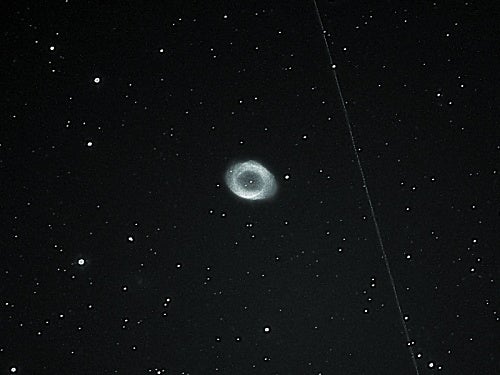Prepare for your Summer Triangle excursion with a naked-eye survey of these stars and their parent constellations. The all-sky map on page 59 will help. Start with Vega, the brightest Summer Triangle member. From mid-northern latitudes, this star appears almost directly overhead after sunset. Vega teams up with a compact parallelogram of stars nearby to form the constellation Lyra the Lyre. A line from Vega through this parallelogram points the way to Altair, part of an even larger stellar parallelogram that defines the constellation Aquila the Eagle. Altair is easily recognizable because it’s the centerpiece of a row of three bright stars. If you follow the Milky Way northward from Aquila, you’ll arrive at the third Summer Triangle star, Deneb, and its parent constellation, Cygnus the Swan. Deneb and four other Cygnus stars form a popular asterism known as the Northern Cross.
Deneb may appear to be the dimmest Summer Triangle star, but it’s actually the brightest — by far. Vega and Altair, at distances of 25 and 17 light-years, respectively, are relative neighbors of ours. Deneb, on the other hand, is 1,800 light-years away. Were Deneb as near as Vega and Altair, it would be an absolutely dazzling sight — a blazing beacon dozens of times brighter than Venus, which is visible in daylight. Huge, hot stellar infernos like Deneb have relatively short (for stars) life spans of a million years or so. They end their lives in spectacular fashion as supernovae. Let’s be glad Deneb is as remote as it is!
Once you’ve scouted the Summer Triangle with the naked eye, it’s time for a binocular and telescopic close-up. Again, start with Vega. Stars don’t look larger when they’re viewed with optical aid, but they appear brighter. Vega is beautiful — a sparkling, pure-white gem. Altair and Deneb also gleam like diamonds. All three are white-hot stars of spectral class A.
While gazing at Vega with binoculars, you might notice a double star close by. This is Epsilon (ε) Lyrae. If you study Epsilon Lyrae with a telescope, with magnification around 100x, you’ll discover each star is actually a double star. Dubbed the “Double-Double,” Epsilon Lyrae is one of the night sky’s finest sights.
Our final Summer Triangle treasure is M57, the Ring Nebula. When a star of average size dies, its core abruptly collapses while the outer layers are shed as an expanding shell of gases. This gas bubble can remain visible for centuries as a planetary nebula. M57 is one of the finest examples. Bright enough to be visible in a small telescope, the Ring Nebula can prove elusive for the novice skygazer. Here’s a strategy to help you capture the Ring. Aim your finder scope toward M57’s lair, midway between the stars Gamma (γ) and Beta (β) Lyrae. With a low-power eyepiece in place, slowly sweep the area, looking for a small, oval patch of light. Once you find it, center it in the field of view, then switch to higher power. In small scopes, the Ring Nebula appears as a solid, ghostly white oval. Its annular (ring) appearance is visible only through 6-inch scopes or larger.
If you have a topic you’d like me to address in a future column, let me know. Be sure it relates to skygazing at the beginner’s level. E-mail me through this web-based form.
Next month: We try a little “VSO-ing.” “What’s that?” you ask. Check back next month. Clear skies.











